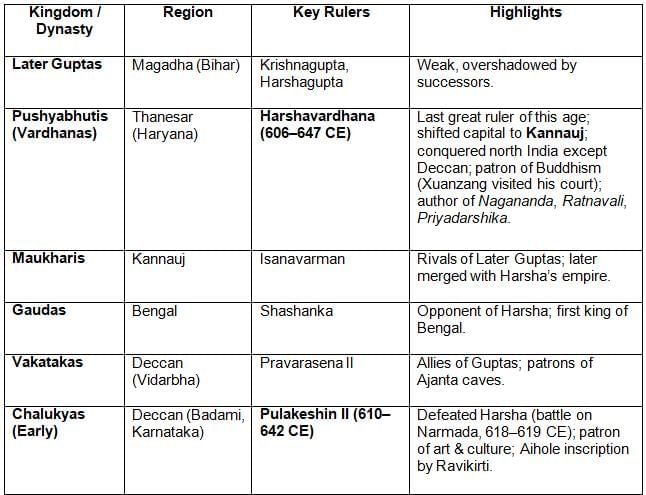SSC CGL Exam > SSC CGL Notes > General Awareness for SSC CGL > Cheat Sheet: Post Gupta
Cheat Sheet: Post Gupta | General Awareness for SSC CGL PDF Download
| Table of contents |

|
| Timeline |

|
| Important Kingdoms & Rulers |

|
| Society, Culture & Economy |

|
| Decline of this Period |

|
Timeline
- Gupta Decline: c. 550 CE (after Skandagupta & weak successors).
- Post-Gupta Period: 550 CE – 750 CE.
- Known as “Age of Smaller Kingdoms” → India politically fragmented.
- Frequent foreign invasions (Hunas, later Arabs in Sindh)
Important Kingdoms & Rulers


Society, Culture & Economy
- Religion: Hinduism revived (Bhakti movement roots); Buddhism declined gradually; Jainism still popular in south & west.
- Education: Nalanda University flourished under Harsha’s patronage.
- Literature:
- Banabhatta → Harshacharita, Kadambari.
- Harsha → Nagananda, Ratnavali, Priyadarshika.
- Art & Architecture: Ajanta caves (Vakatakas), Pallava temples (Mahabalipuram, Kanchipuram).
- Economy: Land grants increased (brahmadeya); decline of long-distance Indo-Roman trade.
Decline of this Period
- Political fragmentation → small kingdoms.
- Rise of regional powers: Palas (Bengal), Pratiharas (Rajasthan), Rashtrakutas (Deccan).
- Frequent wars among Chalukyas & Pallavas in South.
- Hunas & later Arab invasions in Sindh (712 CE – Muhammad bin Qasim).
The document Cheat Sheet: Post Gupta | General Awareness for SSC CGL is a part of the SSC CGL Course General Awareness for SSC CGL.
All you need of SSC CGL at this link: SSC CGL
|
448 videos|1497 docs|288 tests
|
FAQs on Cheat Sheet: Post Gupta - General Awareness for SSC CGL
| 1. What were the key kingdoms that emerged after the Gupta Empire and who were their notable rulers? |  |
Ans. After the decline of the Gupta Empire, several significant kingdoms emerged in India, including the Harsha Empire in northern India, ruled by King Harsha Vardhana, who reigned from approximately the 7th century. In the south, the Chalukyas, with notable rulers like Pulakeshin II, and the Pallavas, known for their contributions to art and architecture, were prominent. The Pala Empire in the east, especially known for its patronage of Buddhism, was another major power during this period.
| 2. How did society and culture evolve in post-Gupta India? |  |
Ans. Post-Gupta India witnessed significant changes in society and culture. The period saw the rise of regional languages and literature, with Sanskrit continuing to thrive alongside vernacular languages. Temples became central to community life and were often sites of artistic expression, showcasing intricate sculptures and architecture. The caste system became more pronounced, influencing social dynamics, while trade and commerce flourished, leading to increased interaction between different cultures.
| 3. What were the economic conditions like in post-Gupta India? |  |
Ans. The economy in post-Gupta India was marked by a blend of agriculture, trade, and urbanization. Agriculture remained the backbone, with advances in irrigation techniques. Trade expanded both domestically and with foreign lands, facilitated by maritime routes and trade networks. Cities began to grow as centers of trade, and craftsmanship flourished, with guilds playing a significant role in the economy, indicating a thriving market environment.
| 4. What impact did religion have on society during the post-Gupta period? |  |
Ans. Religion played a pivotal role in shaping society during the post-Gupta period. Hinduism continued to dominate, leading to the construction of temples and the flourishing of religious literature. Buddhism also saw a revival, particularly in regions like Bengal with the Pala Empire's support. The period also saw the emergence of regional sects and practices, contributing to the diversity of religious life and influencing social structures and cultural practices.
| 5. How did the political landscape change in post-Gupta India? |  |
Ans. The political landscape of post-Gupta India became fragmented, with the emergence of multiple regional powers and kingdoms. This decentralization led to frequent conflicts and alliances between various rulers. The rise of local dynasties, such as the Cholas, Pandyas, and others, marked a shift from a unified empire to a mosaic of independent states, each vying for territory and influence, often leading to cultural exchanges and military confrontations.
Related Searches














